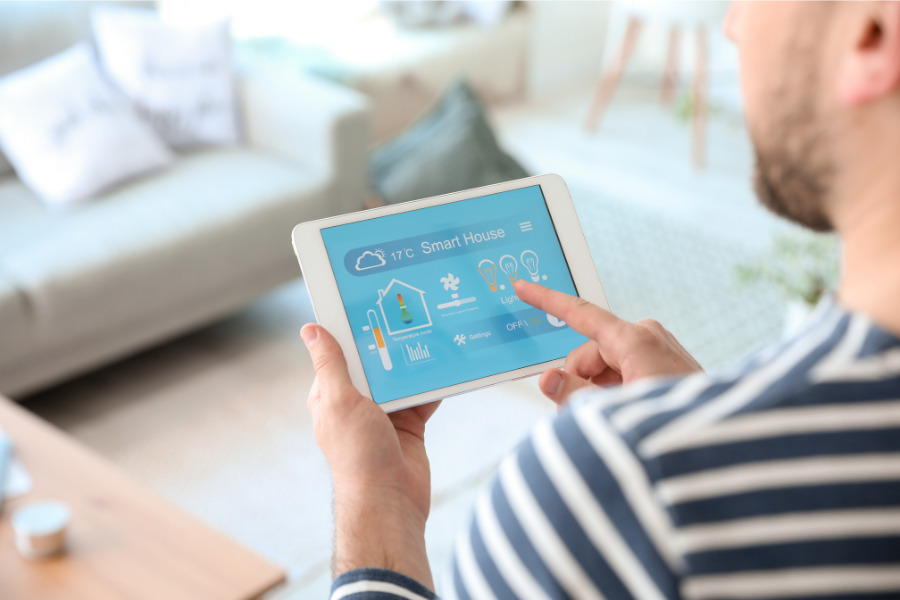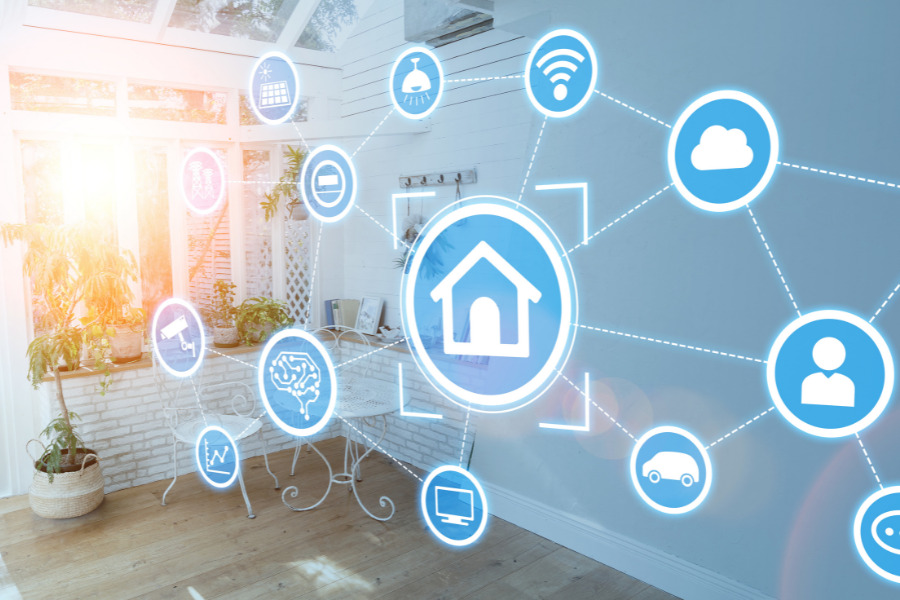Smart Home Systems: The Future Of Home Automation And Security
As technology continues to advance, the concept of a “smart home” has become increasingly popular. A smart home system refers to a range of connected devices and appliances that can be controlled remotely through a centralized hub or mobile app. These systems offer a variety of benefits, including increased convenience, enhanced security measures, and energy efficiency.
Smart home systems have been described as the future of home automation and security. They enable users to monitor and control various aspects of their homes from anywhere in the world using their smartphones or tablets. With these systems, users can turn on lights, adjust thermostats, lock doors, and view video feeds from security cameras all with just a few taps on their screens. Additionally, many smart home systems are designed with learning algorithms that adapt to users’ habits over time for even greater convenience and efficiency.
Advantages of Smart Home Systems
The implementation of advanced technological solutions for residential properties provides homeowners with various benefits that enhance the convenience, efficiency, and safety of their living spaces. One of the main advantages of smart home systems is energy efficiency. These systems are designed to optimize energy consumption by automatically adjusting lighting, heating, ventilation, and air conditioning (HVAC) based on occupancy patterns and environmental conditions. For example, a smart thermostat can learn the occupants’ preferred temperature settings and adjust them accordingly to save energy while maintaining comfort levels.
Another benefit of smart home systems is cost savings. By reducing energy consumption through automation and optimization, homeowners can significantly reduce their utility bills over time. Additionally, many smart home devices are designed to last longer than traditional appliances due to their higher-quality construction and advanced features. This means that homeowners will spend less money on repairs or replacements in the long run. Furthermore, some insurance companies offer discounts for homes equipped with certain types of smart security systems because they are less likely to experience break-ins or other security breaches compared to homes without these features.
Remote Control and Monitoring Features
Remote control and monitoring features have become increasingly popular in recent years, with a survey by Statista revealing that 45% of Americans use their smartphones to remotely control or monitor their homes. One of the most commonly used remote control and monitoring features is smart cameras. These devices allow homeowners to keep an eye on their properties from anywhere, at any time. Smart cameras are equipped with motion sensors and can send alerts to homeowners’ smartphones when they detect movement. Additionally, some smart cameras come with facial recognition technology that can identify family members and send customized notifications when they arrive home.
Another popular remote control feature is voice assistants such as Amazon’s Alexa or Google Assistant. Homeowners can use these devices to control various aspects of their homes including lighting, temperature, and security systems using voice commands. Voice assistants also allow for the hands-free operation of smart appliances such as ovens, refrigerators, and washing machines. This technology provides convenience for homeowners who may have their hands full while cooking or doing other household tasks. In addition to being convenient, voice assistants also enhance home security by allowing users to check on their homes through connected cameras or lock/unlock doors remotely through smart locks. Overall, the remote control and monitoring features provided by smart home systems offer convenience and peace of mind for homeowners looking to automate and secure their homes.
Enhanced Security Measures
Despite concerns regarding privacy and data security, the incorporation of enhanced security measures in modern households is becoming increasingly necessary as the world becomes more technologically advanced and cyber threats become more prevalent. Intrusion detection is one such measure that has been integrated into smart home systems to detect unauthorized access or entry into a property. This feature can be achieved through various methods, including motion sensors, door sensors, and window sensors. Once an intrusion is detected, homeowners are immediately notified via their smartphones or other connected devices, allowing them to take appropriate action.
Another enhanced security measure that has gained popularity in smart home systems is biometric authentication. This technology uses unique physical or behavioral characteristics, such as fingerprints or facial recognition patterns, to verify a person’s identity before granting access to certain areas of the house or controlling certain features of the system. Biometric authentication provides a higher level of security compared to traditional password-based authentication methods since it cannot be easily replicated or stolen by hackers. As such, it offers peace of mind for homeowners who want to ensure that only authorized individuals have access to their homes and personal information.
Growing Demand for Smart Home Systems
The increasing trend towards integrating advanced technologies into households has led to a surge in demand for state-of-the-art solutions that offer convenience, comfort, and enhanced control over various aspects of the living environment. Smart home systems have been growing in popularity due to their ability to integrate with personal devices such as smartphones and tablets. This integration allows homeowners to easily manage their home’s lighting, temperature, security systems, and even appliances from anywhere at any time.
Moreover, smart home systems are no longer exclusive to high-end homes as there are now affordable options available on the market. The demand for these systems is expected to continue rising due to the numerous benefits they offer such as increased energy efficiency and cost savings through automation of tasks like turning off lights when not needed or adjusting thermostats based on occupancy patterns. Additionally, the added benefit of improved home security provides peace of mind for homeowners who can monitor their property remotely using cameras and sensors connected to their smart home system.
Frequently Asked Questions
What are the most common devices compatible with smart home systems?
The top compatible devices for smart home systems vary based on the specific system being utilized. However, some of the most common devices include smart thermostats, lighting controls, security cameras, and voice assistants. By using these devices in conjunction with a smart home system, users can experience a range of benefits such as enhanced energy efficiency, improved security and safety measures, and greater convenience and accessibility. Additionally, the integration of these devices allows for more seamless control over various aspects of one’s home environment. Overall, incorporating compatible devices into a smart home system has the potential to significantly enhance one’s daily life by improving efficiency and reducing stress levels associated with managing multiple systems separately.
How do smart home systems integrate with other home automation technologies?
Integrating smart home systems with other home automation technologies can present a range of challenges. One of the main difficulties lies in ensuring that all devices can communicate with one another seamlessly, despite differences in communication protocols and interfaces. However, the benefits of such integration are substantial. By combining various automated systems, homeowners can create a more comprehensive and intuitive smart home experience. For instance, integrating security cameras with lighting and HVAC systems can allow for smarter energy management while also enhancing overall security measures in the household. Additionally, integration can lead to increased efficiency and convenience as different systems work together harmoniously to accomplish tasks like scheduling appointments or setting reminders. Ultimately, successful integration between smart home systems and other home automation technologies requires careful planning and execution but has the potential to significantly enhance the functionality and user-friendliness of today’s modern homes.
What is the typical cost of installing a smart home system?
The cost of installing a smart home system can vary depending on numerous factors, including the size of the house, the complexity of the installation process, and the desired features. Installation expenses include purchasing the necessary hardware, wiring and connecting devices to a central hub or network, and configuring them to work together seamlessly. Budget considerations are also important when planning for a smart home installation since costs can quickly add up. However, it is essential to keep in mind that investing in a smart home system may lead to long-term savings in energy bills and enhanced security measures. Therefore, homeowners should carefully consider their needs and budget before deciding on which smart home technology options to pursue.
Can smart home systems be easily customized to meet individual preferences and needs?
Personalization options have become a key feature in smart home systems, allowing users to customize their devices and services according to their individual preferences and needs. User-friendly interfaces are integral to this process, as they enable users to access and adjust settings easily. With the advancement of technology, many smart home systems now offer a wide range of personalization options, including voice commands, mobile apps, and web-based dashboards. These allow users to tailor their system’s functionalities such as lighting, temperature control, security alarms, or other features based on their own schedules or routines. With customization capabilities at the forefront of smart home systems design, homeowners can now enjoy greater control over their living environments than ever before.
How do smart home systems impact energy efficiency and sustainability in the home?
Smart home systems have a significant impact on energy efficiency and sustainability in the home. By incorporating smart devices that are designed to be energy efficient, homeowners can reduce their carbon footprint and save money on utility bills. For instance, smart thermostats can automatically adjust the temperature of a room based on occupancy and ambient conditions, reducing unnecessary heating or cooling. Further, smart lighting systems can turn off lights when a room is vacant, reducing electricity usage. These benefits of energy-efficient devices in smart homes significantly contribute to the overall sustainability of modern homes.
Conclusion
In conclusion, the advent of smart home systems has brought about numerous advantages that have revolutionized the way we manage our homes. The remote control and monitoring features afforded by these systems have made it easier for homeowners to control various appliances and devices in their homes from a single location. Furthermore, these systems have enhanced security measures that offer peace of mind to homeowners who are away from their homes.
The growing demand for smart home systems is indicative of their popularity among homeowners today. It is clear that these systems represent the future of home automation and security. As the technology continues to evolve, it is expected that even more advanced features will be developed, further cementing smart home systems as a must-have for any modern homeowner. In light of this trend, it would be wise for homeowners to invest in this technology sooner rather than later, lest they fall behind in the race toward an automated future. After all, as the saying goes: “Time waits for no man.” “And neither does technology, so it’s important to keep up with the latest advancements to ensure a comfortable and convenient lifestyle.”



